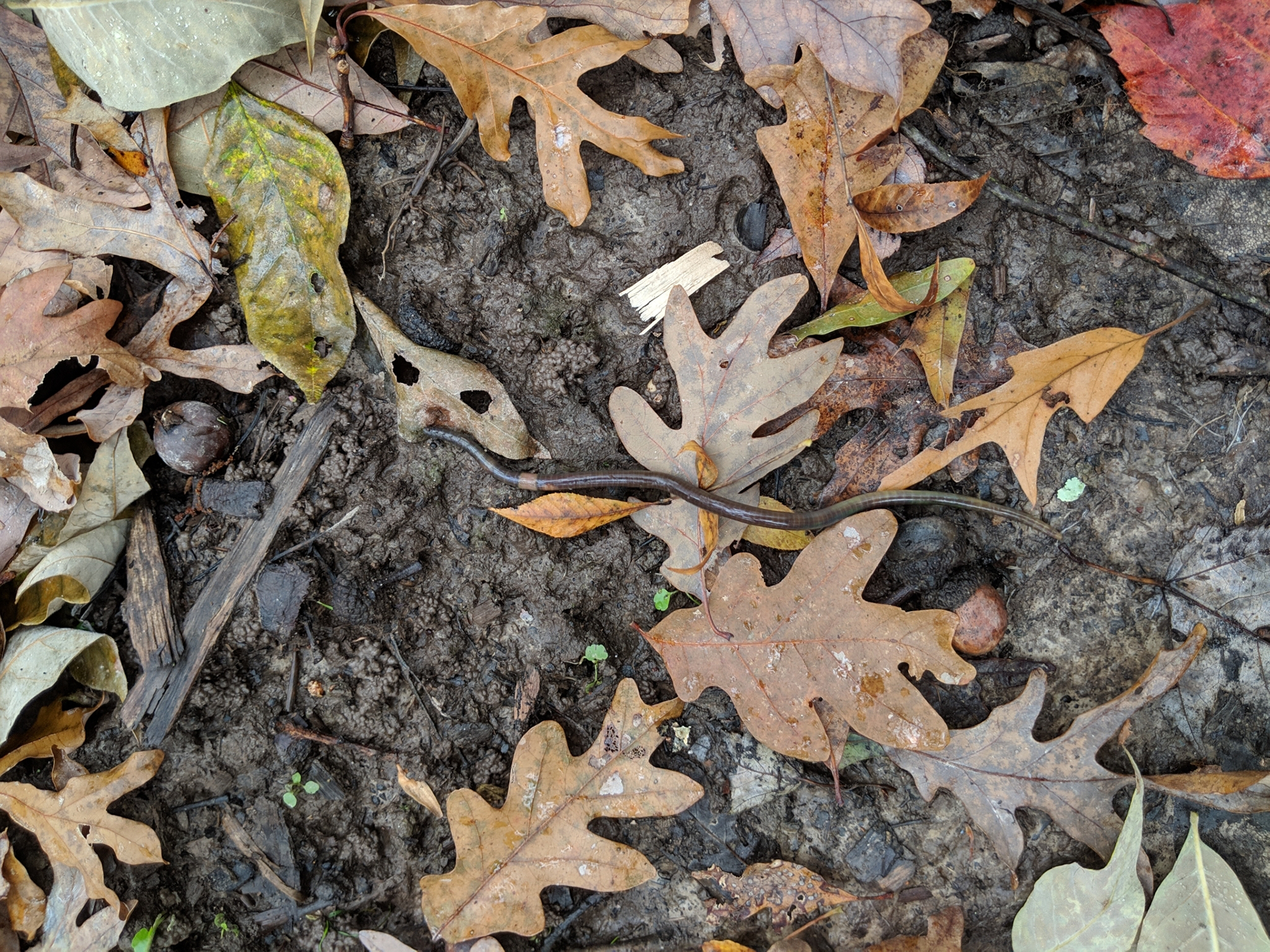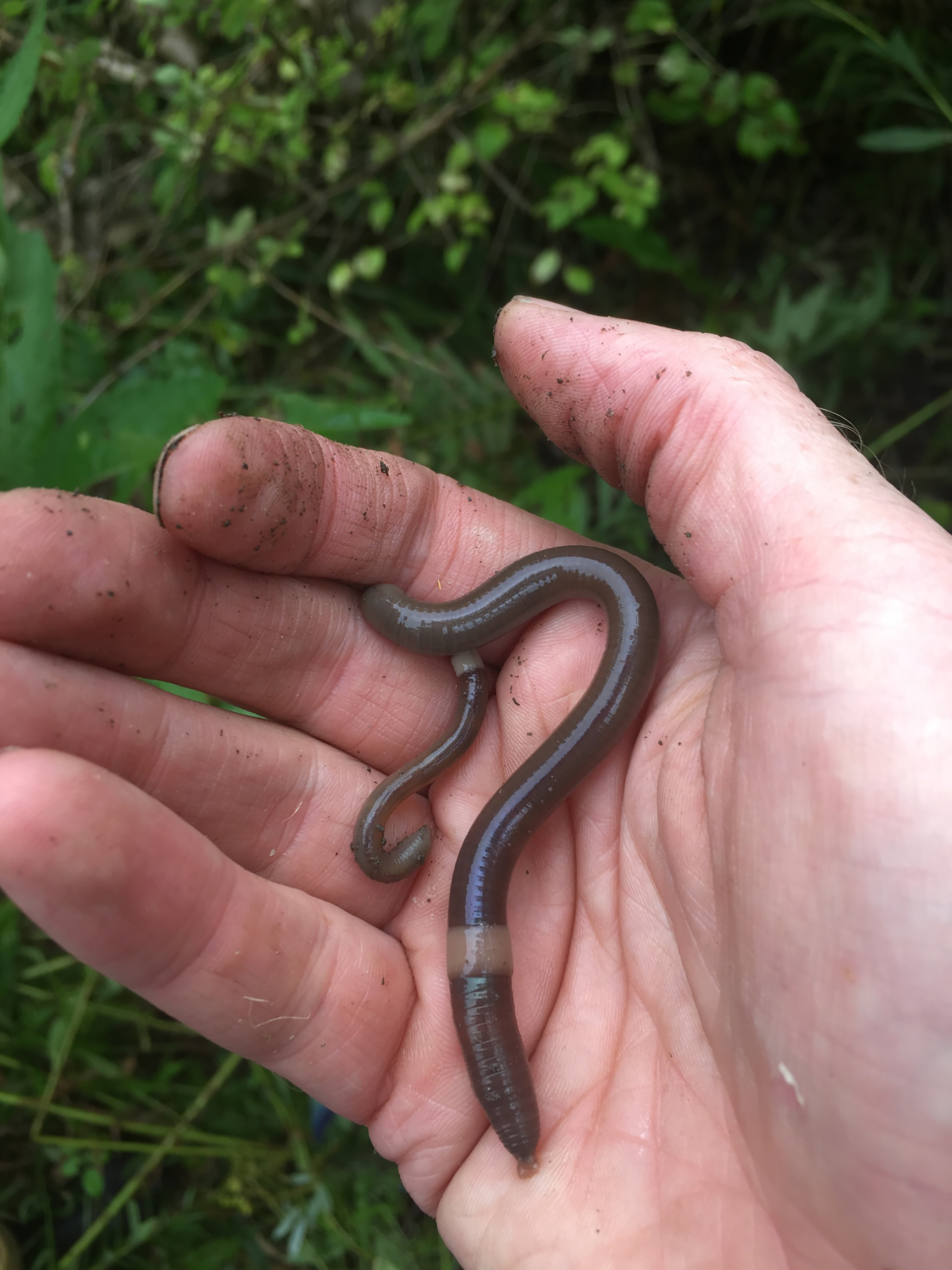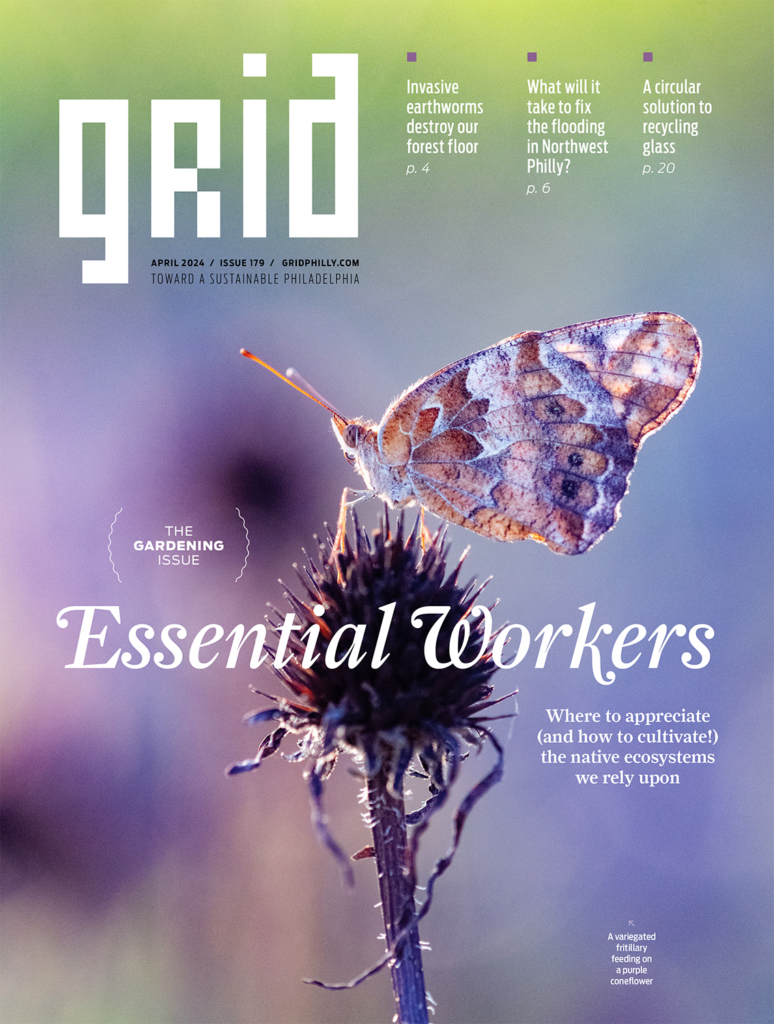Earthworms can be a gardener’s friend. They can transport nutrients from the soil surface to layers deep underground where roots can access them. Their burrows are passageways for water and air. By aerating soil and mixing nutrients, most species of earthworms support cultivated plants.
In forests, however, where lingering leaf litter is critical to forest health, earthworms are disruptive. Plant life in forests in Wissahickon Valley Park, Pennypack Park, Haddington Woods and other woodland in Philadelphia depend on the dead leaves that fall every autumn. Leaf litter replenishes humus and soil as it slowly decays. It provides substrate for seeds to germinate, releases nutrients, holds moisture, shelters seedlings and impedes erosion.
Anything that destroys leaf litter degrades these services. Vehicular and pedestrian traffic on the forest floor crushes it, but the most pervasive destroyers reside within the leaf litter itself and the soil beneath it: non-native earthworms.
There are 23 documented species of earthworms in Philadelphia. More than three quarters of them are not native to North America.
Non-native earthworms in forests today accelerate the breakdown of leaf litter, thinning that critical layer of the forest floor and altering the release of nutrients. There are 23 documented species of earthworms in Philadelphia. More than three quarters of them are not native to North America; most are native to Europe.
Their introduction likely followed many routes, starting with the first European colonists. Earthworms and their cocoons (containing eggs) can be transported in soil, mulch, compost, potting mixes, firewood and by water flowing over land. Cocoons may hitchhike on footwear, tools and vehicles and in leaves bagged for recycling. Other potential modes of importation and dissemination include local and international trade in worms for fishing bait; sale and swapping of plants in soil; and vermicomposting.
The most disruptive non-native earthworms are three species of jumping worm, also known as snake worms and crazy worms (named for how they violently thrash around when disturbed). They are native to Japan and South Korea and are parthenogenetic, meaning they reproduce without mating. They have been recorded in 29 states in the U.S., mostly in the eastern half of the country. The Pennsylvania Department of Agriculture has classified one (Amynthas agrestis) as an invasive species of concern in the state.

In Philadelphia, jumping worms likely arrived in soil accompanying plants shipped from Asia. Andorra Nursery, founded in Philadelphia in 1886, was one of many nurseries that could have unintentionally imported jumping worms. In 1907, its catalog featured six kinds of Japanese trees and shrubs. One hundred acres of the former nursery are now part of Wissahickon Valley Park. Three species of jumping worm were identified in the Wissahickon Valley more than 60 years ago. Currently, photos posted on iNaturalist.org show jumping worms in Northwest Philadelphia, which includes Wissahickon Valley Park.
Similar nurseries have brought other critters into the country. The former Thomas Meehan Nursery, founded in 1854, was located in Germantown and Mount Airy. Its catalog in 1898 offered more than 30 named species and varieties of Japanese trees and shrubs. Around this time or before, it inadvertently imported into North America the Chinese praying mantis, which is native to Japan as well as China and other countries in Asia. This insect is now common in Philadelphia and much of the U.S.
Compared to native and other non-native earthworms, jumping worms concentrate more in leaf litter, particularly in moist conditions. Reaching high population densities, they can completely strip leaf litter from a section of forest and cover the denuded ground with their fecal casts (excrement), which can look like coffee grounds or ground meat and are easily washed away by rainwater. The worms’ fecal casts also make the soil more basic, which makes it harder for native forest plants, adapted to acidic conditions, to grow. The jumping worms can also degrade gardens by eating through mulch and exposing roots of young plants.
The history of earthworms in our region puts the disruption caused by these non-native worms into perspective. During the last ice age, permafrost enveloped the region that now includes Philadelphia and killed all native earthworms. After permafrost thawed and forests reappeared, fungi and bacteria broke down the leaves that fell every year. The slow speed of decomposition gave leaf litter time to build up and gradually release nutrients into the soil.
Twenty years ago, researchers at Philadelphia University (now Thomas Jefferson University) and the Schuylkill Center for Environmental Education described how jumping worms transformed the forest floor in a study site at the center. The density of jumping worms averaged 75 individuals per square yard. By early summer each year, the worms had consumed all the leaf litter from the previous autumn and had left the topmost layer of soil, consisting of their casts, bare and exposed. Most of the plants growing on the surface were the invasive Japanese stiltgrass.

Jumping worms are probably here to stay. Predators such as birds, centipedes, flatworms, salamanders and snakes have not eliminated them. In the laboratory, heat of 104 degrees Fahrenheit or higher for at least 72 hours killed jumping worm eggs. Controlled forest fires have reduced but not eliminated viable eggs.
The effects of environmental change and climate warming on jumping worms are difficult to predict. The worms die with the first frost and the species overwinter in the egg stage in cocoons. Overwintering cocoons hatch after temperatures reach 50 degrees or more and the new generation of worms dies if temperatures then drop to 41 degrees or lower. Climate warming that advances the seasonal time of hatching and improves survival of hatchlings theoretically could increase abundance of jumping worms. By contrast, climate warming that increases mortality of adult worms, which are vulnerable to hot and dry conditions, could decrease their abundance.
Over time, evolution, adaptation and immigration of ecological enemies — including predators, parasites and pathogens — of jumping worms in Philadelphia might moderate their abundance. In the last century in Philadelphia, such enemies helped control an outbreak of the Japanese beetle, a pest that the Henry A. Dreer Nursery in South Jersey inadvertently imported in soil mixed with plants (likely Japanese iris) from Japan.
Policy recommendations focus on slowing the worms’ spread and reducing their impact where they have become established. Precaution in management of soil, mulch and compost may slow their spread. Planting native trees and shrubs in forests may replace those that jumping worms have suppressed. Mapping forest floor stripped of leaf litter and covered with granular casts could guide efforts at remediation.
Jumping worms are unlikely to disappear any time soon. We can work to slow their spread, but we may have to learn to live with them.









Is there anything a gardener should do if we find these in our area?
We have been dealing with Jumping worms for about 2 years since we moved into Mount Airy. I’ve pull out over 200 in our super small row home yard. Just picked out 10 more today (April 16, 2024). They really are quite destructive to the soil. Not totally sure what to do to help, other than keep pulling them out, but I do know also that disturbing the soil too much is also not good. It seems though I’m in good company because scientists don’t know what to do yet either.
I’ve noticed that since we had to have our soil flipped over to replace a main drain, some were 6 inches or more underground. I saw one today that was buried deep and it was bluish. I wonder what that is about. I am sure I’m dealing with jumping worms, since we were super infested (now we are just infested) with jumping worms and sent pictures to scientist to verify (with a video). They clearly snake around when put in vinegar.
I think the public needs to be aware of this devastating threat or it will spread worse.
Putting mustard water in soil maybe will draw out a few but you’d need a ton off it to draw out more. That can’t be great for the soil either.
I’m considering some combo of bio char (clearly good for soil) with a sprinkling of diatomaceous earth (which also has bad effects on other good things in the soil. So I’m a not sure if it’s wise.
I’d be happy for my yard to be part of a study. We did just plant some native bushes (a red osier dogwood, before last winter, and a cranberry viburnum) which are both doing fine so far, fingers crossed.
A very thorough account of the problem earthworms, especially so-called jumping worms, pose for our local forest. Areas of bare earth caused by worms are quite prominent in the Wissahickon .. I hope methods of counteracting earthworm damage can be developed. Ken Frank’s essay is a valuable wakeup call.